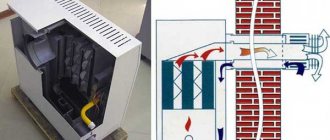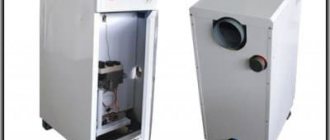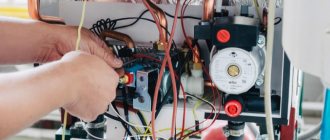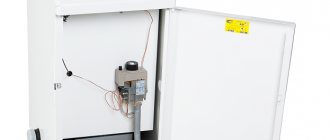General characteristics of AOGV boilers
The abbreviation AOGV stands for Gas Water Heating Unit.
Different manufacturers in the instructions for this technique allow for minor nuances and differences in the decoding of its name, but this does not affect the overall meaning.
If the letters of the name are followed by numbers, they indicate the power of the device.
Efficiency and temperature
If you plan to choose a heating boiler that guarantees maximum efficiency, then purchasing an AOGV is an absolutely justified step. It produces about 92% of maximum efficiency, which was achieved thanks to the special design of the heat exchanger.
These devices are used in heating systems operating using forced or natural movement of coolants. The main condition for the normal functioning of AOGV gas boilers is atmospheric pressure in the system, which does not exceed 1.4 atm. The operating temperature range of these heating devices is from 40 to 90 degrees.
Power
Modern boilers of the AOGV type have been known on the Russian market for about 15 years. As a rule, they are designed to heat rooms with a total area of about 200 square meters. and have a power of up to 30 kW. It is not practical to use such devices for heating rooms with a small area (less than 100 sq. m.).
These heating boilers are considered energy-independent and operate exclusively on the basis of natural gas.
Most often they are produced in a floor-standing version. The following models are most widespread on the domestic market:
- comfort;
- station wagon;
- economy
The choice of type of heating device depends on its price category and the size of the room.
Properties of AOGV
Boilers of this type have become popular due to the fact that they have the following advantages, which were highly appreciated by consumers:
- The easy operation of this gas appliance allows you to safely and easily set the temperature within certain limits.
- The use of modern nanotechnologies in production guarantees high precision and error-free operation reliability.
- The boiler is considered non-volatile and does not require any connection to the electrical network.
- The equipment is compatible with polypropylene, cast iron, steel and other materials.
- Some models provide the ability to turn off the gas manually, which will ensure safety in an emergency or in the event of failure of automatic elements.
- The AOGV device from some manufacturers may be equipped with a circuit water heating system.
- The heat exchanger of heating devices of this type is durable and reliable.
- AOGV is not afraid of natural gas fluctuations.
- The coolant temperature can be adjusted manually.
These boilers have an optimal level of thermal protection, which ensures the most complete use of the energy of the used gas.
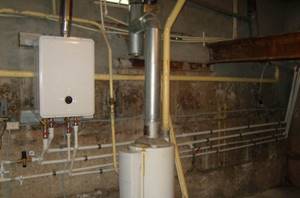
An attractive factor for the modern consumer, which helps to choose the right heating equipment, is environmental friendliness. Minimizing the emission of harmful substances after complete combustion of gas is due to the design of the micro-flare burner.
An important advantage is the adaptability of the gas device to the conditions of the Russian climate.
Cons of boilers
The high cost of a gas unit compared to some types of similar equipment is the main disadvantage of such a boiler. There are others:
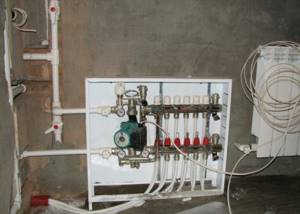
- Certain difficulties in finding spare parts.
- Automation of outdated configurations on selected models.
- Bulky design.
- Aesthetic imperfection (the unit looks like an industrial-type device, which may not suit some users).
Advantages and disadvantages of AGV
The list of positive qualities of AGV is as follows:
- Independence from electricity. This quality is often fundamental when choosing an AGV. The equipment in question does not require electricity at all to operate, so it will fit perfectly in situations where there are problems with electricity, or if there is a desire to save money on it.
- Cheapness. Compared to any foreign analogues, AGV wins in everything related to the cost of equipment. This advantage remains such even taking into account the extremely low efficiency of autonomous gas water heaters.
- Economical. AGVs are rightfully considered one of the most economical types of gas heating equipment.
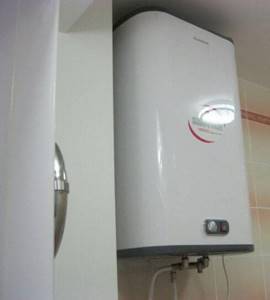
The disadvantages of AGV come down to the following list:
- Big sizes. To install an AGV, about 1 m3 of space is required - which is quite a lot. Often a separate room is allocated for the installation of such equipment.
- Appearance. From a visual point of view, AGV is a purely utilitarian thing that does not have the slightest aesthetic value. In addition to the unpresentable appearance of the heater itself, the heating system is necessarily supplemented by large pipes and radiators, so you have to be sophisticated to create a good interior.
Third stage: connecting the gas boiler to the water supply
Modern double-circuit gas boilers are connected to the water supply system. Fundamentally, these works do not differ from connecting to a heating circuit. Differences in pipe diameters and taps. In places where cold water is supplied, special filters are installed to prevent dirt and debris from entering the unit. There are many examples of boilers failing due to poor quality water. To simplify installation and ensure quick replacement of shut-off valves, special detachable connections are used - “American ones”.
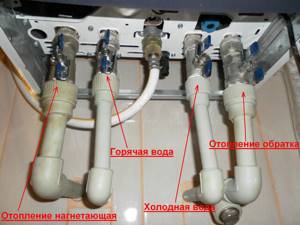
In gas units, cold water is supplied to the left, hot water to the right (relative to the center). When connecting single-circuit gas boilers to the heating system, water supply networks will only be needed to pump water into the water circuit.
Operating principle of AGV
The main structural element of the AGV is the container in which the coolant is heated. When gas burns, a heat exchanger, made in the form of a pipe and installed inside the AGV housing, heats up. The heat from the heated pipe is transferred to the coolant, which is subsequently sent to the heating circuit.
Gas combustion products are discharged through a chimney built into the boiler design. All automation is a valve that opens the gas burner. Thanks to the operation of the valve, the required temperature is constantly maintained in the tank.
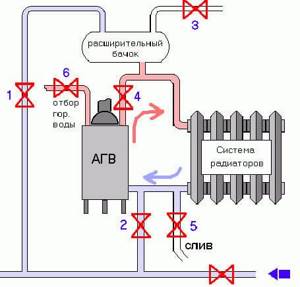
AOGV boilers also have an automation unit that turns off the device in case of a number of problems:
- Traction disorder;
- Significant reduction in gas supply pressure;
- The igniter stops burning.
Immediately behind the AGV, the following elements of the heating system are installed sequentially:
- Expansion tank;
- Heating devices located in each room requiring heating;
- Main pipeline providing distribution of heated coolant;
- Upper pipe distribution;
- Return pipe.
To know how an AOGV gas boiler works, you need to imagine the physical laws that arise in the heating system during its operation. The heated coolant has a lower density, which allows it to independently rise above the cold liquid. The coolant enters the main pipeline, is carried through the heating devices, gives off heat to them, and returns to repeat the heating cycle.
In AOGV boilers, the liquid moves by gravity, without any additional effort. If during the heating process the coolant expands too much, then its excess is drained into the expansion tank. This element is installed on the uppermost section of the heating circuit. When the temperature in the circuit decreases, the coolant returns to the OGV gas boiler.
To increase the efficiency of the system and make it more stable, you can supplement the AGV with a circulation pump, which forces the coolant to move forcibly and ensures more uniform heating of all sections of the circuit. It must be remembered that the pump requires electricity to operate - and the main advantage of the AGV is its independence from electricity.
How to handle AGV
When working with boilers of this type, you need to take into account some of their features:
- AGV for heating a house must be installed in a separate room;
- the diameter of the chimney should not be less than 135 millimeters, and the pipe should be placed outside above the roofing material. In this case, the outer part of the chimney and the part located in the attic is insulated and insulated. A pocket is installed in the chimney itself to collect debris that has fallen into the chimney.
Only representatives of the gas industry can connect the AGV to the gas pipeline; they must register the device. It is imperative to insulate the pipeline through which the coolant will rise to the radiators, but it is not necessary to insulate the return circuit.

If the house uses a scheme with natural circulation of the coolant, then this device must be installed below the location of the radiators. Most often, AOGV gas heating boilers are installed in the basement or a separate room with a recessed floor is built.
The diameter of the pipes is selected exactly according to all canons of plumbing requirements. It is also necessary to set the correct tilt angle of the horizontal sections of the pipework.
This angle should be 1 cm per 1 m of pipeline length. This condition must be fulfilled, as this improves water circulation, reduces the likelihood of air locks, and, if necessary, helps drain water from the system for the period of its conservation or for repair work.
When the temperature reaches +50, condensation begins to appear on the walls of the pipes and boiler, which shortens the service life of the metal components and components of the system. And at this temperature, the coolant itself stops circulating.
Gas boilers AOGV from JSC Borinskoe
The Borinsky plant produces rectangular heaters, with automation in the rear.
The second most popular manufacturer of AOGV is the Borinsky plant. It offers 7, 11, 17, 23 and 29 kW heaters. Such a wide range allows you to choose a boiler even for a small house up to 70 sq. m. This is convenient when there is no point in overpaying for a more powerful unit. At the same time, the Zhukovsky plant can offer customers gas boilers AOGV 11.6 - this is the minimum value.
The Borinsky plant produces two modifications of heaters:
- normal - single-circuit;
- combined - double-circuit.
Boiler burners are made of stainless steel. Copper DHW heat exchanger. The heater body is painted with polymer paint. The unit has built-in temperature regulators to prevent it from overheating, a thermocouple to control the gas supply, and a draft stabilizer. The latter smooths out differences during strong gusts of wind, and in the event of a complete lack of traction, it blocks the gas supply and, accordingly, the operation of the unit. Natural or liquefied gas is suitable as an energy carrier.
Heater parameters
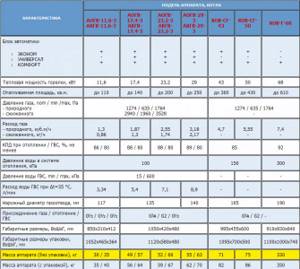
When choosing heating equipment, you need to pay attention to its technical characteristics:
- rated power: 11.6-29.0 kW;
- fuel consumption: main - 1.9-3.56 cubic meters/hour, bottled - 0.86-1.21 kg/hour;
- heating area: 120-400 sq.m.;
- Efficiency: 85-90%.
The body can be rectangular (for high-power models) or cylindrical.
Installation of AOGV in a heating system

AOGVs are installed in private homes.
Installing an AOGV in a private house will cost one and a half times less; on average, the cost of a heater is 20 thousand rubles. Such units can operate in both sealed and open systems. In the latter case, the circuit depends only on the gas supply; there are no energy-dependent devices in the boiler.
The do-it-yourself installation scheme for AOGV in a private house is standard. Consider a sealed circuit:
- the supply from the boiler goes straight to the radiators (air vents must be installed in them);
- a pump is placed on the return line in front of the boiler - installing a pump is allowed in any place, but on the return line it is more correct;
- A mud trap is placed in front of the pump along the coolant flow - this is mandatory;
- The expansion tank is also installed before the pump - this is necessary for the correct operation of the expansion machine.
In an open system, the expansion tank plays the role of an air vent. It can be placed on the supply, immediately above the boiler, or on the return. The main thing is that it is at the highest point. In gravity systems, certain slopes must be observed, then an electric pump is not needed. If the circulation in an open circuit is disrupted, then installing a pump will easily solve this problem; you can even not replace the expansion tank with a sealed one.
AGV modifications
Considering the variety of modifications of gas water heating devices on the market, it is worth understanding how the AOGV differs from a gas boiler. Looking ahead a little, there is no fundamental difference between the devices; all the differences lie in small nuances.
If we talk in detail, then everything that distinguishes an AOGV from a boiler comes down to the following points:
- Glass thermometers have been replaced with modern Italian components;
- Honeywell products began to be used as automation elements;
- The design is supplemented with a piezo ignition device;
- The last difference between the AOGV and the boiler is that the appearance of modern modifications has been slightly improved, for which a higher quality coating has been used.
Energy and energy equipment
Research Institutes of Energy Energy companies Energy saving technologies Sale of heating boilers Repair of heating boilers Cleaning of boilers and heat exchangers Design and construction of boiler houses Boiler equipment - production, sale, repair Construction of energy facilities Construction, repair and maintenance of energy facilities Power plants - equipment Diesel power plants, sale RusHydro Pipes and pipeline fittings Electrical installation work Cable industry enterprises Electrical products, sales Gas industry, gas equipment Oil and gas industry - enterprises in Moscow Sale and transportation of petroleum products Petrochemical enterprises Energy audit Energy equipment Air conditioners and fans, sales Electrical goods stores Leroy Merlin electrical goods
Boilers of these brands are produced
by the Zhukovsky Machine-Building Plant (ZhMZ)
, the largest enterprise in Russia producing household gas heating boilers.
Therefore, these boilers are often called Zhukovsky
.
ZhMZ is located in Zhukovsky, Moscow region. Since 1967, the plant began producing household heating boilers AGV-120, widely known in all regions of Russia and the CIS countries. Currently, the plant produces more than 30 types of AOGV, AKGV and KOV with power from 11 to 68 kW. Zhukovsky boilers are used in electrically independent autonomous water heating and water supply systems. New modern equipment and highly qualified personnel allow us to produce competitive products and the plant to be the Russian leader in the production of gas equipment for autonomous heating and water supply systems. Boiler AOGV-17.4 Gas floor-standing boilers AOGV
are used for heating residential buildings and domestic premises in heating systems with natural or forced water circulation.
The boilers are single-circuit and are used only for heating. For hot water supply, a double-circuit analogue is used - AKGV boilers
.
The abbreviation “AOGV”
stands for
“Gas Heating Unit”, “AKGV - “Combined Gas Unit”.
Those. The AOGV boiler is used only for heating, while the AKGV boiler allows for the selection of hot water for domestic needs. The boilers operate on natural gas, and when replacing nozzles (on the main burner and igniter) - on liquefied (cylindered) gas. The boiler heat exchanger is steel. It has a special design that allows achieving a boiler efficiency of at least 89%. The model range of AOGV boilers includes devices with a power from 7 to 23.2 kW and allows you to heat rooms with an area of 25 to 200 m2. The AKGV boiler range includes devices with a power from 11.6 to 23.2 kW and allows you to heat rooms with an area of 50 to 200 m2. The distinctive qualities of boilers of these brands are simplicity and reliability of design, unpretentiousness, and ease of use. These qualities allowed the AOGV and AKGV boilers to gain popularity in Russia. The AOGV boiler can be found in many country houses and in houses with apartment heating. Gas heating boilers AOGV and AKGV can be used both in systems with natural circulation of coolant (open system), without connection to the electrical network, and in systems with forced circulation of coolant (closed system) with the installation of a circulation pump. Based on serial boilers AOGV and AKGV, it is possible produce modular boiler houses of various capacities When AOGV and AKGV boilers operate in the heating system, low-freezing liquids recommended for use in heating systems can be used as a coolant
Single-circuit boiler
Almost all modern models of gas heating boilers have the same design of incoming and outgoing pipes used to connect gas, heating and water supply. The pipes are located as follows:
- For gas - in the center;
- For the heating system - coolant supply on the far left, return on the far right;
The sequence of actions for connecting a gas boiler to the heating system is as follows:
- Shut-off valves. Ball valves are installed on both the supply and return pipes. They are needed to quickly disconnect the heating system from the boiler if repairs are necessary. The tap can be connected to the pipe directly or through plug-in connections: a union nut or an American one. All professional installers recommend using additional connections that greatly facilitate the process of connecting and disconnecting the boiler to the system. The American version is more expensive, however, it justifies itself by providing a more reliable connection that does not leak even with frequent use.
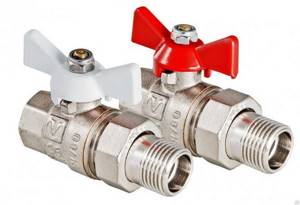
- Coarse filter. Water, which is most often used as a coolant, circulates through the heating system and washes dirt out of it. Solid insoluble particles can settle in the heat exchanger, significantly reducing its efficiency. To avoid this, a coarse filter—a “mud filter”—is installed on the return pipe. It is mounted directly after the ball valve connected to the boiler, and is also separated from the rest of the heating system by a second valve. This is done so that the filter can be cleaned without disconnecting it from the pipes and without draining the coolant from the system.

Coarse filter
IMPORTANT! It is permissible to install the filter only in a horizontal position with the storage compartment facing down.
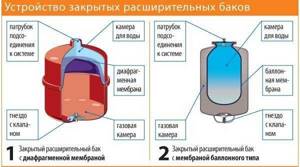
Closed type expansion tank device
The safety group is installed at the highest point of the heating system on the coolant supply pipeline. The recommended distance from the boiler is no more than 1.5 m.
Insertion of AOGV into heating
Since it is not difficult to include AGV in home heating, you can do it yourself, but you will first need permission from the utility services. The insert involves connecting the unit to the heating pipes, as well as to the gas main. To prevent scale particles and dirt from getting inside the boiler, coarse filters must be installed on the inlet pipes. All threaded connections are sealed using tow and O-rings.
Shut-off valves are installed on water pipes. Only a person who has permission to do this type of work can connect the boiler to the main gas line. The gas pipe is also connected with additional sealing. When connecting, copper products or corrugated hoses are used.
Rubber parts are not used because over time they crack and can leak gas, which, if accumulated in the room, will lead to disastrous consequences. A union nut is used to secure the corrugated hose.
Practical advice for choosing AOGV
You can choose the right boiler for your home by following the recommendations of experts:
- it is necessary to have information about the square footage and dimensions of the building or room that is planned to be heated;
- it is advisable to take into account the opinion of professionals;
- inquire about the availability of a service center that will repair the gas boiler if it fails;
- simultaneously with the boiler, you can calculate the required number of heating radiators and their installation diagram.
Main operational characteristics of the AOGV and AKGV boilers
Boiler brandThermal power, kWAutomationHeating square, m2Weight, kgAOGV-7-3 AOGV (AKGV) -11.6-1 AOGV (AKGV) -11.6-1 SIT AOGV (AKGV) -17.4-1 AOGV (AKGV) -17.4-1 SIT AOGV (AKGV) -23.2-1 AOGV (AKGV) -23.2-1 SIT AOGV (AKGV) -23.2-1 SIT with Zhukovsky connection AOGV (AKGV) -29-1
| 7 | EUROSIT | 25-60 | 40 |
| 11,6 | Orion | 40-90 | 45 |
| 11,6 | EUROSIT | 40-90 | 45 |
| 17,4 | Orion | 70-140 | 50 |
| 17,4 | EUROSIT | 70-140 | 59 |
| 23,2 | Orion | 90-200 | 54 |
| 23,2 | EUROSIT | 90-200 | 54 |
| 23,2 | EUROSIT | 90-200 | 54 |
| 29 | Nova SIT | up to 250 | 58 |
Manufacturers of boilers AOGV and AKGV
.
The Boiler Equipment Plant OJSC Borinskoye
has been producing AOGV boilers for more than 15 years and during this time has made a number of significant changes to the basic design of the boilers. Improvements such as: •modern design of the heat exchanger and gas burner device, •increased efficiency, •possibility of installing a copper circuit, •use of imported automation, •polymer painting,
From AGV to AOGV
AGV boilers have a number of undeniable advantages:
- Easy to use
- non-volatile
- reliable
- are inexpensive
- durable
It would be unreasonable to refuse a heating unit with such impressive advantages, so manufacturers modified them, changing the name: now the boilers are called AOGV, which means Gas Water Heating Unit.
AOGV boilers are produced by the Zhukovsky Machine-Building Plant and JSC Borinskoye
New generation of AGV devices
Russian factories produce AOGV - 23.2 - 1. This is a household heating gas cylinder. It is intended for heating houses with an area of 140 - 200 square meters. meters. There is also a device with slightly less power for heating an area of 100 - 140 square meters. m. Otherwise, these two types of heaters are practically no different from each other.
Recently, a more modern model AKGV - 23.2 - 1 with a water circuit has appeared. It can also be used to heat a home and supply hot water. And instead of a pipe running inside the boiler, three steel sections are installed, which are made using a special stamping method and are hollow inside. The sections are mounted vertically and are connected into one chimney, through which gas combustion products flow into a separate chimney pipe.
How to choose gas heating boilers?

New generation of AGV devices
Water is heated using a special coil, which encircles the entire circuit inside the boiler and the water that is used for everyday life flows through it. And in the boiler the water for heating is also heated. That is, it turns out that this device is two in one.
The new model includes an injection burner, which ensures efficient combustion of gas without residue. This type of burner works perfectly even when the gas pressure in the pipeline is low.
AGV: gas water heating apparatus
AGV is nothing more than a gas water heating apparatus, widespread, or rather practically the only gas heating boiler in our country during its Soviet period. It is not surprising that this is what all gas-fired heating boilers in our country were called.
AGV boilers had a primitive design, but they worked properly, providing heat to the house, and what can I say, they still work.
In essence, an AGV boiler is a tank of water, the heating of which occurs in the same way as the heating of any vessel installed on a gas burner. The burner is located under a water tank, and combustion products are removed through a heat exchanger located in the center of the tank and passing into the chimney. To increase heat transfer, the heat exchanger has a ribbed shape.
This design of the boiler ensures a high level of heat exchange and efficient heating of the coolant entering the boiler through the lower pipeline and leaving it through the upper ascending pipeline. When properly installed and connected, AGV boilers provide effective natural coolant circulation.
Automation of the new AGV
It completely controls the entire process of heating water. And the automation unit itself consists of:
- a temperature sensor that controls the water temperature;
- an electromagnet, which is responsible for controlling the main gas supply valve;
- thermocouple, which is mounted near the igniter. Heated by a constantly burning torch, it creates an electric current in the circuit;
- traction sensor. It is mounted in the chimney and controls the optimal draft of the pipe.
Modernization of AGV boilers by the manufacturer
The boiler manufacturer AGV was in no hurry to discontinue them due to obvious advantages.
However, taking into account that this equipment needed a thorough modernization, the following design changes were made:
- Fragile glass thermometers have been replaced with more reliable instruments made in Italy;
- The new systems were equipped with automation from the American company Honeywell;
- To turn on the device with a handle, a piezo ignition system was used;
- New coating technology has made the appearance of the unit more aesthetically pleasing.
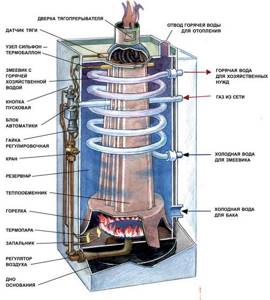
Boiler diagram AOGV - 23
Rules for handling the heating system
The unit is installed in a separate room. It is advisable that this room be soundproofed, since when the boiler burner is turned on, a rather loud bang occurs.
In some new modifications (AOGV-23.2-1-U), this drawback has been largely eliminated, since when the water overheats, the automation does not turn off the burner completely, but switches it to a mode in which the flame is minimal.
A chimney (with a diameter of 140 mm) for combustion products is installed outside residential premises. Below the junction of the pipe from the heating tank with the chimney, there is a garbage container - a “pocket” for foreign objects and waste that accidentally fell into the channel.
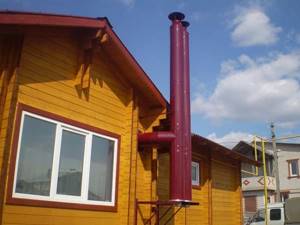
Option for a chimney for AGV in a private house
Note! You should not connect the unit yourself. It must be carried out by gas service workers. In this case, the device is registered.
For the unit, a room should be allocated in the lower part of the building. The ascending pipeline needs insulation. The return line should not be insulated.
The installation instructions for heat transfer devices (radiators, convectors and heating panels) provide for their installation at the highest possible height from the unit itself. To circulate layers of air, such devices should be installed under windows. The return pipeline is laid under the floor of the room.
If the return line is laid above the door jambs, airing of the system may occur.
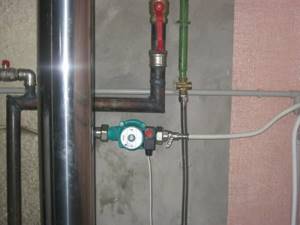
General view of a fragment of the pipe layout of a heating system with AGV
Two-inch network pipes do not look very aesthetically pleasing, however, when replacing them with pipes of smaller diameter, it is necessary to take into account that as the diameter of the pipe decreases, hydrodynamic resistance increases, which weakens the water pressure in the system. This, of course, can seriously impair the performance of such a unit.

AOGV connection: rear view
During installation, pipelines are installed with a slope of 1 cm for each meter of pipe length. This avoids the appearance of air locks in the system, facilitates water circulation and allows water to be drained from the system.
This video examines some practical issues of installing AGV in a private home:
Some Caveats
- When the water temperature in the system drops below 55-50°C, condensate begins to release abundantly. If it accumulates, it can extinguish burners;
- Combustion products, when mixed with condensate, form nitric and sulfuric acids, which cause corrosion of equipment;
- If the water temperature in the system drops below 50°, then its circulation in the system almost completely stops;
- If the room is not heated in winter, the water from the system must be drained, but in this case corrosion increases significantly;
- To get hot water without heating the entire system, you can use a tap that shuts off the circulation in the heating system. And if you connect the forward and return lines, you can maintain turnover.
Have a warm winter!
System installation
All installation work begins after the project has been drawn up and approved by the relevant organizations. The technical specifications for the design are issued by the gas industry. The main requirements in it are for the room in which the boiler will be located.
Particular attention in the technical specifications is paid to general ventilation, the installation of chimneys, and the presence of gas analyzers. The distances from the walls when installing equipment are also regulated.
Connecting the boiler to the heating system.
It is necessary not only to study how the system works before purchasing it, but also to consult with specialists whether it is possible to install the unit in the intended location.
Where installation is possible
The use of an underfloor heater in most cases is due to one reason: natural circulation will be difficult if the boiler is located much higher than the level of the radiators.
This type is used very rarely, and even then after significant alterations, as a result of which their classification as traditional AGV is very conditional. Consulting with a specialist will help you choose the optimal location and type of boiler.
Pipeline layout
This type of heating system is open and is installed with overhead piping. Moreover, it can be single-pipe or double-pipe. Which one to choose is decided in each specific case individually.
Installing a two-pipe system allows you to turn off heating appliances using shut-off valves, but then the circulation resistance of the coolant increases sharply. Without the use of a pump, this can create problems during the operation of the heating system of an apartment or house.
Nuances of pipeline installation
During the installation of pipelines, an expansion tank is installed at the maximum possible height, which will accept the excess volume of water when it is heated. An overflow pipe is welded into it.
The diameter of the pipes for water supply and return drainage must be at least 50 mm. Such a significant increase in size is necessary to reduce the coolant resistance. They are installed with a slope to avoid air pockets.
Slope Options
The optimal slope is 1:100. The direction of the slope of the upper (supply) manifold is downward from the expansion tank to the first radiator. The lower (return) pipeline must have a slope from the last radiator to the AGV. are installed in the upper plugs of heating radiators, and the make-up valve is installed in the return line.
System layout.



